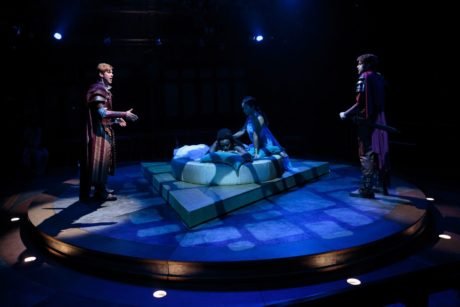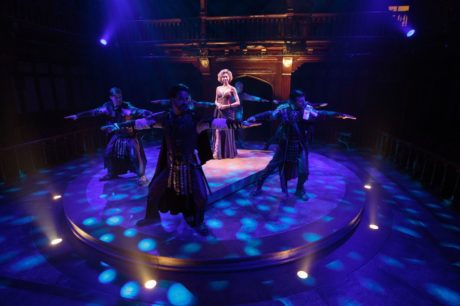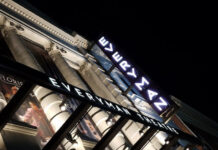Folger’s production of Antony and Cleopatra directed by Robert Richmond has garnered its rightful share of critical acclaim. Its lighting design is a critical component of the production’s striking visual presence. There was a cinematic feel to the production; scenes-within-scenes, scenes that had both color and film-noir-like black-and-white lighting aspects. I was smitten with the audacity of its arena staging as the production moved between dry land and the sea, between Rome and Egypt. The lighting provided verve and emotion.
read Sophia Howes’s enthusiastic review here
Wanting to know more about the development of the Antony and Cleopatra lighting design, I took the opportunity to interview lighting designer Andrew F. Griffin.
For those less familiar with Griffin, he has received two Helen Hayes Awards for Outstanding Lighting Design; one for his work on Henry V at Folger Theatre and the other for his working on King Lear at Synetic Theatre. This column is edited from my interview with Griffin.
David Siegel: How would you describe the role and responsibilities of a lighting designer?
Andrew F. Griffin: Well, it begins with conversations with the director and the creative team. This particular production was unique in that we were having those conversations during our breaks as we tech-ed Timon of Athens. Of course we talk about the world of the play, but I also want to know what psychological world we’re creating. What is its rhythm? How should we be perceiving this world from the audience?

After those meetings, I go to my studio and create a light plot, and work with the producers to acquire any additional equipment we might need to execute the production. This can take some time; you’re thinking about how the director might use the space, anticipating where scenes might happen, and anticipating what scenery might move – even before the play is in rehearsal.
The biggest part of our job happens in tech. Lighting is really a unique discipline in that we can’t really create any content until we are in the theater looking at the set, the costumes, and are living in the world of the play. Yes, the lights are in the air and focused where they need to be from the plot. But each of those lights is not singularly a piece of content, it’s how we use them to support and build on everything else. Much like a painter paints, or a musician writes music, we use the lights as brushes or notes to create the atmosphere of the play. And we do this in conjunction with everything and everyone else. We are one of the last people to lay our work into place, and so we have to take care to keep the integrity of not just our work, but the work of the entire team.
Why did you want to light Folger’s Antony and Cleopatra?
First, I love working with this team of collaborators. We push each other creatively, and there is a lot of trust within this team. Antony and Cleopatra is our fifth show together, and while the text posed a number of challenges, I knew with [director] Robert Richmond leading the way we could tap into something that could really be special. For better or worse, I can’t say no to a good challenge, and this team is always ready to test the limits of the Folger’s space. So when Tony said he wanted to do it in the round, I wasn’t surprised.
What were the unique challenges and opportunities in lighting Antony and Cleopatra in the reconfigured Folger Theatre space?
The first challenge of any show is how to create dynamic light. How do you make sure people have highlights and shadow? And that’s usually when the audience is on just one side. So in the arena the question becomes, how do we maintain that visual interest on all four sides? Especially when what is a front light for one side is a sidelight for some and a backlight for others.
Then there’s the added challenge specific to the Folger: the ceiling mural prevents us from hanging a position over the stage to have downlight, which would have been the only angle of light the whole audience could experience the same way. Compounding this challenge was the proximity of the audience to the stage, and not wanting to get light directly in their eyes. The pyramid floating over the stage, which I thought was a brilliant way to cap our space and help direct our focus back to the space below and not up into the heavens of the Folger, also posed some logistical challenges for where light could go. Ultimately, it was a team effort working with the set designer (Tony Cisek) the technical director (Charles Flye) and the Master Electrician (Alex Keene) to add a few more lighting positions to the Folger to a) light around the pyramid, b) stay out of the audience’s eyes, and c) create dynamic light for the production. I can’t speak highly enough about the production department at the Folger. They make the impossible happen.

The other big challenge was space. The Folger is designed for the lights to be concentrated in areas that are logical to its standard configuration. While we were able to add positions for lighting, real estate was still very valuable for the whole team. It is not uncommon for me to be limited in how many lights I could hang in certain places. Usually, though, I’m just pushing to have two or three instruments in the same place. For this arena configuration, we were talking about seven, eight, or even nine instruments. While you wouldn’t be able to tell looking in the air, this is honestly one of the smallest hangs I’ve ever done for the Folger because space was so tight. This challenge was solved with a rental of some intelligent fixtures (four Martin Mac Viper Profiles) to put in those primo spaces. They served their purpose and then some. This would be a different show without those fixtures.
On your web site, you use the word “intersections” for lighting, what does that mean to you?
In the micro context of what I said on my website (“work that explores the intersectionality of light and music to create emotional and visceral experiences for a live audience”), music has always been a part of my life and it’s my belief that light is a visual representation of music. Lighting Design is what you see when you close your eyes and listen to music. That’s what I try to tap into with every production. Even when it’s not an opera or a musical, the spoken word has key, meter, and tempo. A playwright give us verses, refrains, a-and-b sections, key and meter changes. Shakespeare especially does that. I try to tap into the auditory poetry of the piece and create a space that suits the music, whatever it may be.
I believe I’m creating a psychological and emotional space for the actors to inhabit. It turns the light into an additional character and allows the audience to experience the piece more viscerally.
Talk about the collaboration with other designers.
I want to start with my collaborations with Sound. They are always a critical part of my work in tech. Lighting and sound are ephemeral arts, so we need to be conscious of each other and work together to create a cohesive atmosphere. We make sure the transitions are in sync with each other and give each place its own unique ambiance.
With this particular team, we are beginning to have our own language, which is fantastic especially when you’re creating under a time limit. Robert Richmond [director], Tony Cisek [scenic design], Mariah Hale [costumer design], and I are good at talking with each other throughout the process to isolate what’s working, what’s not, who can solve it, and how. For my part, sometimes it’s as simple as changing a gel or a cue’s timing, or as complex as re lighting a scene. The simple fact is: the story comes first and we all work together to support the story.
Please tell me about several scenes in Antony and Cleopatra that you are particularly proud of.
I have to start with the sea battle. Shakespeare doesn’t stage it, but I knew when we signed on for this that Robert would. We gave you the battle of Agincourt in Henry V, why would we not give you this battle? Then when we knew we were going to be in the round, I knew it would fall on me to help give that scene some clarity. What the lighting helps the audience feel – between the swirling floor and the blue green color – is a sense of that churning water. It puts us in a place completely different than any other we’ve been in all night. It’s a very brief moment in the play, but one I’m very proud of, and again is one of those team effort moments where everyone gives something to the story.
While it’s not a scene, per se, I am also proud of how we transition from Rome to Egypt, and Egypt to Rome. We were always trying to anticipate ways to make sure this show did not become a scene shift ballet, but we also needed it to be very clear whether we were watching from the Roman or the Egyptian perspective for each scene. Working with Adam Stamper (the sound designer) we created percussive transitions that snapped us out of Egypt and into Rome, then when transitioning to Egypt we used a dissolve. It helped us create a sonic and visual language for an audience to know where we were instantly so you’re never feeling left behind and can keep your focus on the action at hand.
Running Time: Approximately two hours, with a 15-minute intermission.
Antony and Cleopatra plays through June 11, 2017, at Folger Theatre – 201 East Capitol Street, SE, in Washington, DC. For tickets, call the box office at (202) 544-7077, or purchase them online.




